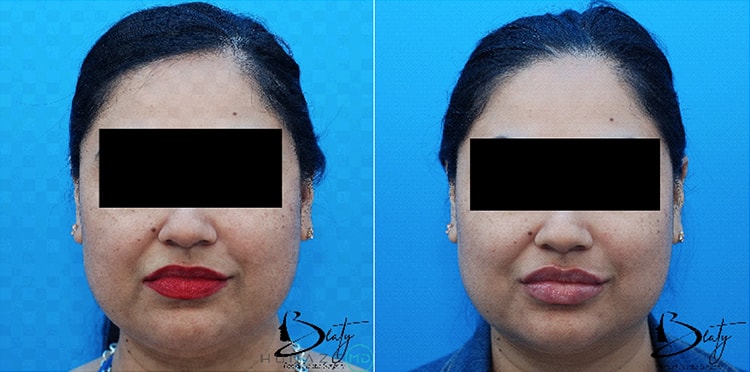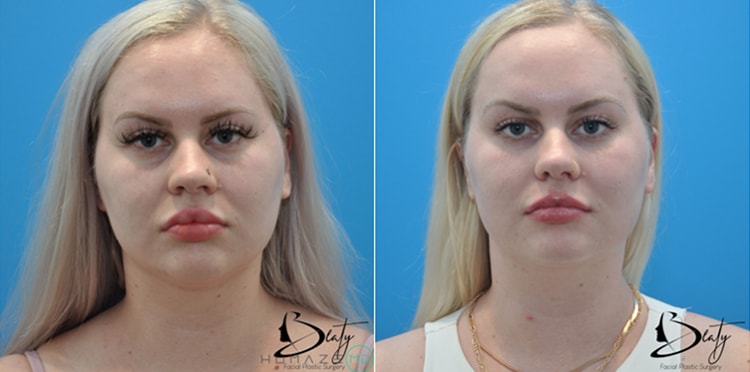 Lip filler has long been the procedure “to do.” Every patient that comes to see me has heard of it, researched it, and has questions regarding it. Lips are the most artistic portion of what I do in the aesthetic space. It requires multiple techniques and approaches to achieve the desired outcome of the patient. It is never a bad idea to bring in pictures of what you would like to achieve. In today’s space there is Hyaluronic acid (HA) lip filler (which is most commonly used), lip implants or a surgical lip lift (which both involve a surgical procedure), and fat transfer (a more permanent option). I inject HA fillers. They are easily dissolved and easily managed. There are also several different types. This allows us, as your provider, to make a plan for you that will best meet your goals. For the purpose of this blog, we will discuss HA fillers—such as Restylane® and JUVÉDERM®—and the results we can accomplish with them.
Lip filler has long been the procedure “to do.” Every patient that comes to see me has heard of it, researched it, and has questions regarding it. Lips are the most artistic portion of what I do in the aesthetic space. It requires multiple techniques and approaches to achieve the desired outcome of the patient. It is never a bad idea to bring in pictures of what you would like to achieve. In today’s space there is Hyaluronic acid (HA) lip filler (which is most commonly used), lip implants or a surgical lip lift (which both involve a surgical procedure), and fat transfer (a more permanent option). I inject HA fillers. They are easily dissolved and easily managed. There are also several different types. This allows us, as your provider, to make a plan for you that will best meet your goals. For the purpose of this blog, we will discuss HA fillers—such as Restylane® and JUVÉDERM®—and the results we can accomplish with them.
During the consultation, it is my job to assess, 1. Whether we can realistically meet your goals, and 2. How long and what is required for us to achieve your desired aesthetic. There is a common misconception in this space that one syringe will make you look like a duck. It will not. Most of my patients have at least 2 syringes of filler in their lips and none of them look like a duck.
So pre-procedure is the consultation. My patients and I sit and discuss the look they are trying to achieve. I formulate a plan for that desired outcome and we can start immediately or whenever is comfortable for the patient. Most plans require a multiple syringe, multiple appointment series in order to get to the finish line. Once the desired look is achieved, I have my patients come back in the 3-4 month timeframe to “touch-up.”
A touch-up is not wanting another syringe to make the lips larger. It truly means to maintain the result.
With your filling appointment, we take pictures, consult for the final time to make sure that my goal is your goal, numb, then fill. Afterwards the lips are swollen for 1 week. The first two days are the worst. I recommend ice and elevation to help the fluid gather. Your filler gathers water so this is completely normal. There may be bruising, especially with new lip filler clients.
A very rare but serious complication is occlusion. This means that, instead of the filler going into the correct space in the lip, it is injected into an artery or vein. This blocks blood flow and causes tissue death. Any provider injecting HA filler should know how to treat this. I go over this with all of my clients before and after injecting. If I see a sign of this during your injection, we immediately start treating so that there is no tissue damage. A good provider knows how to treat an adverse event quickly in order to have the best outcome for the patient.
There are several types of lips that I come across when working in this space. Those are noted below in addition to an example of the treatment plan.
1. M-Shaped Lips
This is one of the hardest to fill, but one of the most rewarding when it is. It takes time and patience to get there. The provider has to keep in mind migration of filler due to the amount of volume this look takes to achieve. This took 1 syringe of filler over 2 sessions. She could have gone larger. Her lips and her face would have accommodated it, but she loved her look after one syringe. Her lateral aspects are still thin and in order to achieve lateral fullness, the provider has to build those aspects. This takes time and volume.
Volume = Fullness.

2. Small Lips
This patient came to me with smaller lips. Starting with smaller lips, the provider must always be aware of stretch and migration. In order to add volume to smaller lips, you must be in the right space or migration will occur. If the provider volumizes too quickly there can also be migration or worse, an occlusion. This look took 3 syringes of filler over the course of 6 sessions and about 24 months.

3. Larger Lips
Larger lips are, by far, the most fun to inject. Most often they have the space to expand. These patients are used to having larger lips and are not afraid of the swell. They actually LOVE the swell. These lips take filler beautifully. The shape is mostly present. We are just accentuating it. There may be some asymmetry that needs to be corrected, but for the most part, these lips just want to go larger.

4. Correcting Lips
I have had several patients come to see me after seeing a provider elsewhere. They do not love their result and want to change it. This results from lack of consultation, the provider not having the necessary experience, or the provider just injecting to make money. This patient in particular went to a provider that did not do a consultation and injected her lips with a filler that was thicker than she needed. It created gathering in the upper tubercles creating a “ball” appearance that this patient did not like. We started with dissolving. This took 2 sessions over 6 weeks. We let the lips heal for 4 weeks after the last dissolving session, then started refilling. We filled slowly and followed up several times throughout her re-filling process. I looked for migration and gathering in the upper tubercles. These pockets did tend to gather filler and when that began to happen, we let her lips heal longer before reinjecting. Corrected lips take time, patience, and many follow ups. Done correctly, they can turn out beautifully.

With any procedure, it is imperative that you trust the process and the person going through that process with you. It is your face and our expertise. If it does not feel right, find someone else. There is always someone out there for you. Trust no one but the best with you and yours.






